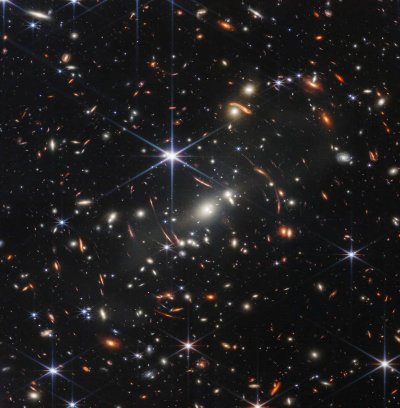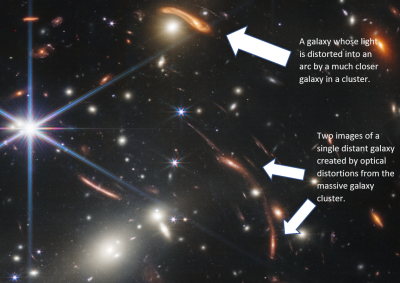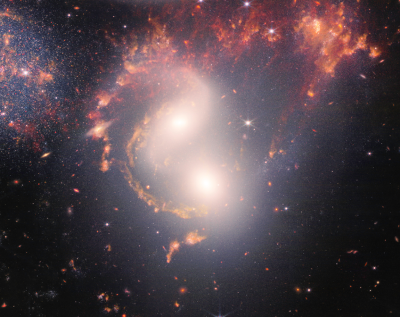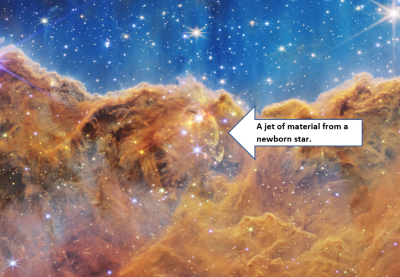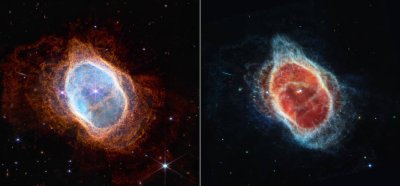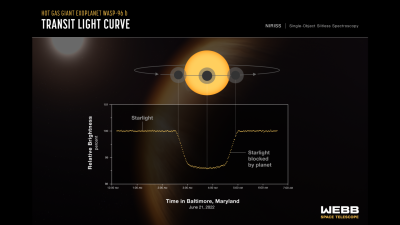WWU Astronomy & Planetary Science professors share the science behind the new images from the James Webb Space Telescope
The images are unprecedented due to the fact that the JWST collects infrared light, which travels in longer, lower-energy wavelengths than the visible light that the older Hubble Space telescope collected. As a result, it can “see” objects much farther away in much sharper resolution than Hubble could.
For example, the image of gallery cluster SMACS 0723 not only reveals a cluster of galaxies in incredible detail, it also shows galaxies in the background that have never been seen before, said WWU Astronomy Professor Ken Rines.
“Infrared light is so exciting because it allows you to see these galaxies that are really far away,” Rines said. “They emitted optical light (light we can see), but the expansion of the universe stretched that light out, so instead of reaching us as optical light it reaches us as infrared light.”
These ancient and extremely distant galaxies are some of the ones that show up as red in the image. Scientists can also tell that they’re much farther away than the cluster of white-colored galaxies because their image is distorted, Rines said.
“The light from the background galaxies gets bent and distorted into arcs and sometimes rings,” Rines said. “The mass of the cluster distorts space-time and makes [light from distant galaxies] a little like a funhouse mirror.”
One example is in the zoomed-in view of the larger picture. One of the reddish distant galaxies appears to be oozing over a white galaxy in the much nearer cluster. In the same image, one reddish galaxy’s light is distorted so much that it creates two images.
This distortion effect from clusters of galaxies may be the reason why some of the reddish galaxies are visible to JWST in the first place, according to Rines.
“With the cluster there, it boosts how large the images appear and how bright the images appear,” Rines said. “So you can learn a lot about these distant galaxies by looking through a cluster like this.”
The sharpness of the JWST’s images may also reveal new information about the Stephan’s Quintet, a group of five much closer galaxies that are on a collision course, according to Rines.
“Even among groups of galaxies, these galaxies are very close together,” Rines said. “And you can see some of these mergers happening.”
Rines pointed out that two of these galaxies are far along in the merging process. These mergers happen very slowly, Rines said, and this one is a few hundred million years from completion.
This process is important to understand because the closest galaxy to the Milky Way, Andromeda, is on its way to collide with us, said Rines. It’s due to arrive in about four billion years.
“When that happens, aliens looking at the Milky Way and Andromeda might see something similar to how we see these two galaxies in this image,” Rines said.
Luckily, stars are so far apart even in galaxies that the orbit of planets around them will remain largely unchanged, Rines said.
In the Stephan’s Quintet, scientists also noticed an unusual amount of star-forming nurseries, called nebulas, Rines said.
The JWST got a close up of the Carina Nebula here in the Milky Way. The image is so detailed because more infrared light can pass through the dense regions of gas and dust than visible wavelengths can, Rines said.
It’s crucial for astronomers to look deeper into the denser regions of nebulas because that’s where stars form best, Rines said.
The Carina Nebula image may also show a little-known process in star formation: a jet of hot gas flowing back into the nebula. Astronomers aren’t certain about why or how this happens, according to Rines.
“One of the things about astronomy that’s fun is that there’s a lot of questions like that where we really don’t know what the answers are,” Rines said.
Yet another mystery the JWST is shedding light on is the death of stars that are about the size of Earth’s sun, Rines said. One example is the Southern Ring Nebula. The gaseous outer portions of the Southern Ring Nebula were once the outer layers of an ancient sun, shed overtime as it got older, according to Rines.
“Images like this show how many times a [dying star’s] surface ejects into different layers and how much time there is between each of those events.”
Astronomers predict that Earth’s sun will start to look like the Southern Ring Nebula in about five billion years, according to Rines.
Not only has the JWST proven its ability to view massive objects from stars to galaxies in detail, it has also revealed new clues about a distant planet called WASP-96b. The planet is 1.2 times the size of Jupiter and 1,150 light years away, according to NASA.
JWST measured the light coming from the star as the exoplanet WASP-96 moved across it. The dip in light from the planet’s orbit is called a light curve.
During these eclipses, the starlight dims regularly as the planet orbits its star. Astronomers can analyze these dips in the starlight to estimate the size, the orbital period and the composition of the atmosphere, according to WWU Planetary Science Assistant Professor Asmaa Boujibar.
Based on the light curve, astronomers already knew that WASP-96b is a giant planet very close to its star. WASP-96b is often referred to in the class of exoplanets called hot Jupiters, due to their large sizes, puffiness and proximity to their host stars.
JWST further analyzed the starlight by looking precisely at how different wavelengths get filtered by the atmosphere.
The resulting data showed “unambiguously for the first time the signature of water in the atmosphere of the hot gas giant WASP-96b, and also the presence of haze and clouds that were thought not to exist based on prior observations,” said Boujibar.
The telescope achieved this by capturing small decreases of brightness at wavelengths typical of water, she said.
“The spectrum of WASP-96B makes us all very optimistic for future discoveries,” Boujibar said. “Researchers will also construct temperature maps of exoplanet atmospheres and combine them with information on their chemistry and presence of haze and clouds to understand the formation and evolution of exoplanets.”
About 5,000 exoplanets - planets outside of our solar system - have been confirmed to orbit other suns in the Milky Way alone and await closer examination, according to the NASA press release.
The JWST is expected to last anywhere from five to ten more years, according to the Goddard Space Flight Center. There are a lot more images to come.
Rines is excited for the JWST to take images within the next year of a galaxy cluster he’s been studying in the Coma Berenices constellation. He plans to work with students at WWU to combine existing images of the galaxies with images from the JWST. For now, Rines is enjoying the images the JWST has already taken.
“They’re beautiful images,” Rines said. “I could look at them all day.”
